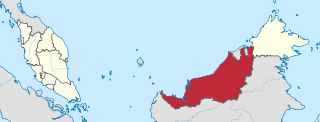
Sarawak is a state of Malaysia. The largest among the 13 states, with an area almost equal to that of Peninsular Malaysia, Sarawak is located in East Malaysia in northwest Borneo, and is bordered by the Malaysian state of Sabah to the northeast, Kalimantan to the south, and Brunei in the north. The state capital, Kuching, is the largest city in Sarawak, the economic centre of the state, and the seat of the Sarawak state government. Other cities and towns in Sarawak include Miri, Sibu, and Bintulu. As of the 2020 Malaysia census, the population of Sarawak was 2.453 million. Sarawak has an equatorial climate with tropical rainforests and abundant animal and plant species. It has several prominent cave systems at Gunung Mulu National Park. Rajang River is the longest river in Malaysia; Bakun Dam, one of the largest dams in Southeast Asia, is located on one of its tributaries, the Balui River. Mount Murud is the highest point in the state. Sarawak is the only state of Malaysia with a Christian majority.

Kuching, officially the City of Kuching, is the capital and the most populous city in the state of Sarawak in Malaysia. It is also the capital of Kuching Division. The city is on the Sarawak River at the southwest tip of Sarawak on the island of Borneo and covers an area of 431 km2 (166 sq mi) with a population about 165,642 in the Kuching North administrative region and 159,490 in the Kuching South administrative region—a total of 325,132 people.

Sir Charles Brooke, Rajah of Sarawak, GCMG, born Charles Anthoni Johnson, ruled as the head of state of Raj of Sarawak from 3 August 1868 until his death. He succeeded his uncle, James Brooke, as the second White Rajah.

Miri is a coastal city in north-eastern Sarawak, Malaysia, located near the border of Brunei, on the island of Borneo. The city covers an area of 997.43 square kilometres (385.11 sq mi), located 798 kilometres (496 mi) northeast of Kuching and 329 kilometres (204 mi) southwest of Kota Kinabalu. Miri is the second largest city in Sarawak, with a population of 356,900 as of 2020. The city is also the capital of Miri District, Miri Division.

Limbang is a border town and the capital of Limbang District in the Limbang Division of northern Sarawak, East Malaysia, on the island of Borneo. This district area is 3,978.10 square kilometres, and population was 56,900. It is located on the banks of the Limbang River, between the two halves of Brunei.

Simanggang is a town and the capital of Sri Aman District and Sri Aman Division in Sarawak, east Malaysia. Located on the Lupar River, it is 193 kilometres (120 mi), a three-hour drive, from Kuching, the capital of Sarawak. It is a trade center for the timber, oil palm, rubber, and pepper of its mostly agricultural district.

Lawas is a small town and the capital of Lawas District, Limbang Division, Sarawak, Malaysia. This district area is 3,811.90 square kilometres, and population was 46,200. It is 1,200 km from the state capital, Kuching and 200 km from the capital city of Sabah, Kota Kinabalu.

The White Rajahs were a hereditary monarchy of the Brooke family, who founded and ruled the Raj of Sarawak as a sovereign state, located on the northwest coast of the island of Borneo in Maritime Southeast Asia, from 1841 to 1946. Of British origin, the first ruler, James Brooke was granted the province of Kuching – which was known as Sarawak Asal – by the Sultanate of Brunei for helping fight piracy and insurgency among the indigenous peoples in 1841 and received independent kingdom status.

The Raj of Sarawak, Kingdom of Sarawak or State of Sarawak, was a kingdom founded in 1841 in northwestern Borneo and was in a treaty of protection with the United Kingdom from 1888. It was formed from a series of land concessions acquired by the Englishman James Brooke from the Sultan of Brunei. Sarawak was recognised as a sovereign state by the United States in 1850, and by the United Kingdom in 1864. The territory of the kingdom is now the Malaysian state of Sarawak.

The Sarawak State Museum is the oldest museum in Borneo. It was founded in 1888 and opened in 1891 in a purpose-built building in Kuching, Sarawak.

Marudi is a town in the Malaysian state of Sarawak, and is a part of the division of Miri. It is the seat of Marudi District, and is located on the banks of Baram River, about 100 kilometres (62 mi) upstream from the river mouth. Marudi was the administrative centre of the northern region of Sarawak before Miri was established in 1910. Marudi is considered as the cultural heart of the Orang Ulu, the highland tribes of Sarawak. It is also a transit gateway to Kelabit Highlands and Gunung Mulu National Park, a UNESCO World Heritage Site.

The History of Sarawak can be traced as far as 40,000 years ago to the paleolithic period where the earliest evidence of human settlement is found in the Niah caves. A series of Chinese ceramics dated from the 8th to 13th century AD was uncovered at the archeological site of Santubong. The coastal regions of Sarawak came under the influence of the Bruneian Empire in the 16th century. In 1839, James Brooke, a British explorer, first arrived in Sarawak. Sarawak was later governed by the Brooke family between 1841 and 1946. During World War II, it was occupied by the Japanese for three years. After the war, the last White Rajah, Charles Vyner Brooke, ceded Sarawak to Britain, and in 1946 it became a British Crown Colony. On 22 July 1963, Sarawak was granted self-government by the British. Following this, it became one of the founding members of the Federation of Malaysia, established on 16 September 1963. However, the federation was opposed by Indonesia, and this led to the three-year Indonesia–Malaysia confrontation. From 1960 to 1990, Sarawak experienced a communist insurgency.

The Brunei–Malaysia border divides the territories of Brunei and Malaysia on the island of Borneo. It consists of a 528.45 km (328.36 mi) land border and substantial lengths of maritime borders stretching from the coastline of the two countries to the edge of the continental shelf in the South China Sea.

The Astana is a palace in Kuching, Sarawak, Malaysia, on the north bank of the Sarawak River, opposite the Kuching Waterfront. It is the official residence of the Yang di-Pertua Negeri Sarawak. The name is a variation of 'istana', meaning 'palace'. It was built in 1870 by the second White Rajah, Charles Brooke, as a wedding gift to his wife, Margaret Alice Lili de Windt. The palace is not normally open to the public, although the landscaped gardens are, which can be reached by a boat ride across the Sarawak River. It is part of the Kuching Heritage Trail.

The Limbang District is one of the two districts of Limbang Division, Malaysia. It has a total area of 3,978.10 square kilometres. The major town is Limbang. It has one sub-district, which is Nanga Medamit Sub-District. It borders Brunei Darussalam to the west and east, Lawas District to the southeast and Miri District at the south and southwest. Due to being squeezed in between Brunei at its north and coastal areas, Limbang is accessible by road only by going through immigration posts.

Fort Margherita is a fort constructed in 1879 by Charles Brooke, the second Rajah of Sarawak, situated in Kuching, Sarawak, Malaysia. The fort is an important landmark and monument in Sarawak's history which goes back to the century-old Brooke dynasty of Sarawak. The fort, built in the style of an English castle, was designed to protect Kuching from attacks by pirates. It served as a Police Museum from 1971 before being handed over to the Government of Sarawak and now is a tourist attraction in Kuching. The fort now houses the Brooke Gallery, an exhibition showcasing the history of Sarawak under the Brooke dynasty.

The Fort Sylvia is a historical fort in Kapit, Sarawak, Malaysia. Built in 1880, it was renamed after Rani Sylvia Brooke, wife of Rajah Charles Vyner Brooke, in 1925. During the 1960s, the fort housed the District Office and the District Court House, and later the Resident's Office when Kapit Division was formed in 1973.

The Crown Colony of Sarawak was a British Crown colony on the island of Borneo, established in 1946, shortly after the dissolution of the British Military Administration. It was succeeded as the state of Sarawak through the formation of the Federation of Malaysia on 16 September 1963.

Jason Desmond Anthony Brooke FRAS is the grandson of the last Rajah Muda of Sarawak, Anthony Walter Dayrell Brooke, and a prominent representative of the Brooke dynasty in Sarawak, modern-day Malaysia.

Fort Hose is a historical fort situated in Marudi, Sarawak, Malaysia. It was built in 1898 by Charles Brooke, the second Rajah of Sarawak, to safeguard government activities in the area, and now serves as a museum.



















